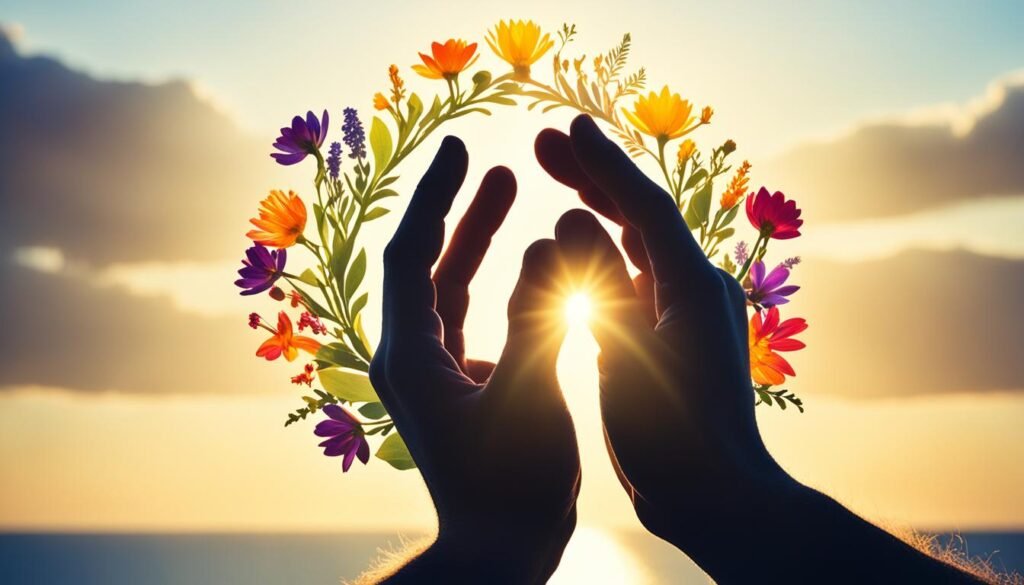What makes a relationship not just survive, but truly thrive? The answer often lies in recognizing the signs of a healthy relationship. A strong partnership is built on a series of fundamental indicators that contribute to the happiness and growth of both individuals. From the ability to communicate openly to sharing mutual respect and support, healthy relationship indicators are the blueprint for a loving and enduring connection.
Understanding how to have a healthy relationship transcends mere intuition—it’s about nurturing the positive aspects that make up the core of your partnership. Whether it’s spending quality time together, maintaining individuality, or aligned life goals, a robust relationship celebrates these aspects in harmonious balance.
Key Takeaways
- Identify and cultivate key signs for a thriving partnership.
- Acknowledge healthy relationship indicators as a foundation for growth.
- Open communication and shared respect are central to strong relationships.
- Maintain the individuality of each partner while fostering collective harmony.
- Align life goals for a synchronized journey together.
The Essential Foundation of Love in Relationships
In the intricate dance of human connection, the foundation of love in relationships is not just a mere ingredient; it is the bedrock upon which enduring relationships are built. Grasping the profound significance of love as the bedrock of connection, partners can mold the strength and resilience required to navigate the ebb and flow of a shared life.
Understanding Love as the Bedrock of Connection
Love’s power lies in its ability to create an unwavering bond, fostering a deep sense of understanding and intimacy between individuals. It’s an enigmatic force that facilitates empathy, compelling us to appreciate our partners’ perspectives and experience the world through their eyes. This unity is the very essence of a lasting coalition, affirming the concept of love as the enduring foundation of love in relationships.
Building a Life Together through Loving Actions
It’s in the tangible gestures of affection where love takes form, transforming the abstract into reality. The day-to-day acts of kindness become the threads that weave a rich tapestry of companionship and warmth. The decisions made and actions taken in service of one another’s happiness testify to the commitment of building a life together, strengthening the ties that bind relationship partners in their shared journey.
The Role of Servant Leadership in Fostering Love
Embarking on a journey of servant leadership within a relationship means voluntarily choosing the path of support, guidance, and nurturing. It is a mutual exchange of empowerment, recognizing that by lifting our partner, we elevate ourselves. Such leadership embodies selflessness and a dedication to the growth and well-being of both individuals, laying a foundation for a symbiotic union where servant leadership in relationships acts as a catalyst for everlasting love.
This conceptual framework for love may seem lofty, but its application is grounded in every smile shared, every meal prepared together, and every hardship surmounted side by side. By seeding the foundation of love in relationships, with patience and nurturing, a flourishing garden of connection is grown, one that withstands the tests of time and tribulation, allowing a lifetime of love to unfold.
Communication: The Heartbeat of Healthy Relationships
Every enduring relationship pulsates with the steady rhythm of effective communication in relationships. It’s the indispensable force that enlivens partnerships, ensuring both individuals feel heard, understood, and valued. As we delve further into this topic, we’ll uncover the core importance of engaging in honest dialogues and the need for clarity and kindness in communication.
Navigating Honest Dialogues Together
Truthful conversations serve as the fundamental pillars of trust within a partnership. Cultivating an environment where both parties can express themselves openly without fear of judgment or reprisal is essential. Such a space allows honest dialogues to unfold, fostering transparency and authenticity, which are the hallmarks of a robust connection.
- Discussing needs and desires candidly.
- Sharing feelings and experiences without reservations.
- Constructively addressing misunderstandings or mishaps.
The Art of Clarity and Kindness in Communication
While being straightforward in exchanges is vital, it is equally important to maintain clarity and kindness in communication. This skillful blend ensures that messages are not only understood but also received in a manner that builds up the relationship rather than breaks it down. Crafting words with consideration and empathy paves the way for a more profound, heartfelt connection.
- Choosing words thoughtfully for clearer understanding.
- Employing empathy to recognize each other’s emotional states.
- Practicing active listening to ensure mutual comprehension.
Adept communication is much more than a mere exchange of words—it’s the art of weaving a shared narrative of two lives, consistently honing the vein of connection with trustworthiness and benevolence at its core.
Resolving Conflicts with Compassion and Care
Resolving conflicts in relationships is a critical aspect of creating an enduring bond between partners. Conflicts, while often seen as obstacles, can be transformed into opportunities for growth and understanding. The journey of moving from confrontation to resolution requires a thoughtful approach and a willingness to engage in direct and loving conversations.
Moving from Confrontation to Resolution
To move from a place of confrontation to one of resolution, it is essential to approach conflicts with an open heart and a clear mind. This begins with creating a safe space where both partners feel heard and respected. Here are several key strategies to consider:
- Recognize and validate each other’s perspectives, even when you disagree.
- Focus on the problem, not the person, to prevent undue blame and resentment.
- Suggest actionable solutions that work for both partners, showing a shared commitment to the relationship’s well-being.
The Importance of Direct and Loving Conversations
Engaging in direct and loving conversations is not only about expressing your views but also about actively listening to your partner. To ensure these conversations are productive:
- Communicate your feelings honestly but kindly, avoiding hurtful language.
- Listen without interrupting, showing that you value their input.
- Use “I” statements to express yourself without casting blame, fostering a collaborative atmosphere for problem-solving.
When both partners are willing to put in the effort, resolving conflicts in relationships can lead to stronger, more resilient connections that endure life’s many challenges.
The Healing Power of Forgiveness
Understanding the healing power of forgiveness is critical in any meaningful relationship. It’s the balm that mends past grievances, allowing couples to move forward with a strengthened bond. Forgiveness in a relationship acts as a pivotal point from where both partners can commence a journey filled with more understanding, empathy, and mutual respect.

When we talk about the forgiveness in relationships, it’s often accompanied by the misconception that it implies condoning hurtful actions. However, forgiveness is really about liberating oneself from the chains of resentment. It opens up a pathway to peace that can lead to the reconciliation of the relationship.
- Letting go of grudges to free up emotional space that can be filled with positive interactions.
- Understanding that forgiveness is a process that requires time and patience.
- Recognizing that a forgiving attitude fosters a culture of compassion and trust.
When partners actively engage in the process of forgiving each other, they reaffirm their commitment and strengthen the foundation upon which their relationship is built. The act of forgiving is an investment in the relationship’s future, one that underscores the resilience of its bond.
- Identify the hurt and its impact on your relationship.
- Acknowledge the emotional struggle and allow space for healing.
- Have open and empathetic dialogues to facilitate forgiveness.
By enveloping forgiveness in relationships with kindness and love, couples can harness the healing power of forgiveness, turning wounds into wisdom and conflict into growth opportunities. This transformative power fortifies the relationship, paving the way for a future where both partners can thrive side-by-side in harmony.
Signs of a Healthy Relationship
A thriving partnership is often manifested through various signs of a healthy relationship. Recognizing these attributes can provide invaluable insights into the strength and vitality of your own connections. Here, we delve into the characteristics of a healthy relationship, noting key traits and qualities that signify a mutually supportive and loving bond.
Healthy relationship indicators are not just about avoiding conflict; they reflect a deeper level of compatibility and understanding. Let us consider some of these indicators:
- Open and honest communication where both partners feel heard and respected
- Equal partnership in decision-making and respecting each other’s autonomy
- Mutual support in personal growth and individual pursuits
- Consistent affection and appreciation, nurturing a deep emotional connection
- Healthy conflict resolution skills that strengthen rather than weaken the relationship
- Shared values and goals that drive the couple towards common objectives
While each relationship will exhibit its unique blend of these elements of a healthy relationship, the presence of these core aspects signals a strong foundation. Signs of a strong relationship are often found in the day-to-day interactions that build trust and create a resilient bond poised to withstand life’s challenges. Ultimately, these characteristics foster love and respect, building a relationship that is not just enduring but also fulfilling and joyous for both partners.
Cultivating Joy: Shared Activities and Interests
The essence of cultivating joy in relationships often blossoms through the mutual experiences and connections formed when couples engage in shared activities and interests. Synchronizing joy with partnership enriches the bond and crafts unforgettable moments of unity. Let’s unpack how integrating these shared pursuits can reinforce the emotional fabric of a relationship.

Finding common ground doesn’t mean both partners must mirror each other’s hobbies to the letter, but discovering a harmonious blend of interests that foster togetherness is key. This can range from outdoor adventures to cultural exploration, from culinary experiments to volunteer work.
- Identifying pursuits both partners are enthusiastic about, leading to a more vibrant and energetic relationship dynamic.
- Learning from each other by taking turns to share and teach personal interests, thus enriching the relationship with new layers of understanding.
- Creating a portfolio of experiences that serve as touchstones for the relationship, reinforcing memories and emotional bonds.
However, the pursuit of shared activities and interests should not become a source of stress or competition. The aim is to enhance the joy within the relationship, not to outshine one another or keep a tally of who contributes more.
- Approach new activities with an open mind and heart, embracing the opportunity to learn and grow together.
- Providing encouragement and support, celebrating both the efforts and achievements as a united front.
- Recognizing that it’s the quality of the time spent together that matters most in cultivating sustainable happiness and joy.
In essence, cultivating joy in relationships through shared activities and interests provides a powerful avenue for couples to strengthen their connection. It’s the tapestry of shared experiences that builds an enduring and joyful narrative, weaving together a relationship that is both fulfilling and joyful.
Respecting Individual Timelines within the Relationship
Every relationship blooms at its own pace, and acknowledging this can be the bedrock for a lasting connection. Respecting individual timelines is not only about accepting different stages of personal growth but also honoring the journey each takes – together and apart. In a world where instant gratification is often the norm, the true depth of a relationship can only be reached by understanding comfort levels and fostering a nurturing environment where both individuals can thrive.
Understanding Each Other’s Comfort Levels
Each person comes into a relationship with unique experiences and boundaries. A fundamental aspect of deepening connection is the sensitivity shown towards these differences. Recognizing and understanding comfort levels ensures that neither partner feels rushed or pressured, allowing love to unfold in the most genuine and organic way possible.
- Listen actively to your partner’s concerns and wishes.
- Create a safe space for open and non-judgmental conversation.
- Recognize signals both verbal and non-verbal, respecting pauses and hesitancies.
Balancing Patience with Progress
While patience is a virtue in nurturing a relationship, it must harmonize with progress – an equilibrium that fortifies the bond. The challenge lies in balancing patience and progress; pushing too hard might lead to resistance, while too much patience can result in stagnation. The key is to encourage growth while allowing each partner the time they need to evolve within the relationship’s framework.
- Set mutual goals and celebrate small milestones along the way.
- Be patient, but also proactive in taking steps towards strengthening the relationship.
- Provide continuous support and reassurance as both partners navigate their individual paths.
At the intersection of personal timelines and shared experiences lie harmony and mutual respect. By understanding and appreciating each other’s individual journeys, couples can create a durable foundation for a relationship marked by empathy, thoughtfulness, and collective growth. Thus, respecting individual timelines, understanding comfort levels, and balancing patience and progress are not just concepts, but actionable approaches to love that respects each partner’s pace while jointly moving forward.
Inspiring Growth: The Drive to Thrive Together
In the journey of a relationship, inspiring growth in relationships is akin to nurturing a garden; it requires care, nourishment, and patience. Growth is not a mere byproduct—it’s a deliberate effort that couples make each day, reinforcing the foundation and joy of being together. This shared commitment to personal development and mutual support is key in driving growth in a relationship.
When partners choose to grow together, they create an environment where trust flourishes, communication strengthens, and bonds deepen. Embracing challenges as opportunities for learning and becoming better individuals contributes to a relationship’s vigor and vitality. Let’s explore how partners can inspire and empower one another to reach new heights.
- Setting joint goals: Crafting a vision for the future not only unites couples in purpose but also aligns their actions towards common aspirations.
- Encouraging individual pursuits: While togetherness is important, supporting one another’s personal interests and ambitions can greatly enhance mutual respect and appreciation.
- Learning from each other: Exchange of knowledge and wisdom is a wonderful way to grow intellectually and emotionally in a relationship.
- Fostering open communication: A dynamic where thoughts and ideas can be freely shared is the bedrock of sustained relationship growth.
- Regularly reflecting on progress and celebrating milestones: Acknowledge and honor the steps taken, both small and large, for they are the stepping stones of growth.
- Embracing vulnerability: Showing genuine self and accepting partner’s true self lays a strong foundation for growth rooted in authenticity.
The act of two individuals driving growth in a relationship is a testament to the resilience and potential of love. When you actively inspire and contribute to each other’s growth, you pave the way for a life not just shared, but truly co-created and flourished with the richness of collective experiences and wisdom.
Community Engagement: Strengthening Bonds Beyond Two
The ties that bind our relationships extend beyond personal interactions and infiltrate the larger fabric of our communities. The cultivation of strong social networks is not merely a social convention but is fundamental to community and relationship health, influencing the longevity and fulfillment we experience individually and together.
How Community Contributes to Relationship Health
Establishing solid connections within our surroundings is a keystone for community engagement in relationships. Data from various studies underscore how strong social ties are linked to a longer life. For instance, those who experience loneliness and social isolation are shown to be at a higher risk for poorer health, depression, and increased likelihood of early death. The reciprocal support found in vibrant communities can alleviate stress and reduce heart-related risks, cultivating an environment where relationships can flourish.
In the quest for finding support in relationships, community engagement acts as a buffer against the detrimental effects of isolation in an unhealthy relationship. Where one partner may be isolated, robust communal ties offer avenues for support and intervention. In the formative years, the quality of an infant’s emotional bond with a parent predicts their future capacity to forge healthy relationships. Moreover, one supportive adult can pivot the trajectory for a child at risk of neglect and abuse, underlining the protective roles that healthy friendships and communal activities play during childhood.
Finding Support and Love in Your Inner Circle
The bedrock for establishing and maintaining healthy relationships is often set in the early stages of life. Unhealthy relationships in childhood, particularly those marred by neglect and abuse, can predispose an individual to similar patterns in their adult life. However, certain factors act as protective shields, preventing the formation of such detrimental bonds. Among these, finding support and love through friends, family, and community members is crucial. In essence, having healthy relationships with others begins with self-regard and extends to the circles one chooses to cultivate.
- Fostering a liking for oneself is foundational to engaging healthily with others.
- Community activities offer safe spaces for individuals and couples to build common interests and mutual support networks.
- The presence of at least one caring adult in the community can significantly improve outcomes for children and adolescents facing adversity at home.
In summation, community engagement enriches relationships by providing a supportive structure around them, demonstrating again and again how our bonds, both personal and communal, sustain our overall well-being.
Celebrating Each Other with Gratitude and Thankfulness
When it comes to celebrating each other in relationships, the role of gratitude and thankfulness cannot be overstated. These emotions strengthen the bond between partners, nurturing a sense of appreciation and mutual respect. Remarkably, a survey of 2,000 Americans highlighted gender differences in gratitude expression—women tend to express gratitude more frequently and to a wider array of individuals, underscoring the diversity of gratitude expression within relationships.
The contrast in how men and women report experiencing gratitude is telling. Women have been found to express not just more regular gratitude, but also a greater feeling of having much to be thankful for. This trait or dispositional gratitude isn’t just an emotional response; it’s a characteristic that amplifies the benefits of celebrating each other in relationships. Conversely, research suggests that men may hold back in expressing gratitude, particularly older American men, who often choose to conceal rather than express thankfulness.
The implications of these differences can ripple through the dynamics of a relationship. Men who demonstrate less gratitude might face challenges in relationship building and maintenance, potentially influencing their interactions both personally and professionally. Moreover, men might experience feelings of obligation or burden when on the receiving end of help, gifts, or favors, a sentiment less commonly reported among women.
- Cultural factors may partially explain why some men reportedly experience difficulty in expressing gratitude.
- Various studies, including one from 1988, have demonstrated that such attitudes towards gratitude are not universal, with German men reporting higher frequencies of gratitude experiences compared to American men.
- Gratitude’s importance for men’s well-being aligns with its significance for women, illustrating that gratitude stands as a unisex pillar of emotional health.
To encourage a deeper sense of gratitude, ingraining habits such as maintaining a gratitude journal or writing letters of thanks can be particularly effective. These activities have been proven to significantly boost feelings of gratitude, especially in men. So, whether it’s within the domestic sphere or external environments such as the workplace, integrating gratitude and thankfulness into daily life is essential for celebrating each other in relationships and creating a fulfilling partnership for everyone involved.
Conclusion
In reflecting upon the key takeaways on healthy relationships, it’s clear that the strength of our social bonds can significantly impact our mental and emotional well-being. Dr. Fisher emphasizes that healthy communication is the cornerstone of any positive relationship, allowing individuals to listen actively and converse without judgment. It fosters an atmosphere of trust and respect, which are pivotal for creating a safe and nurturing environment for both parties to grow.
Maintaining a network of varied relationships, including those of romance, friendship, and associates, enriches our lives and augments our overall well-being. Infused with the essence of mutual care, a healthy relationship thrives on shared efforts, quality time, and an unwavering commitment to one another’s happiness. The benefits of such relationships are numerous, from lowered stress levels and increased longevity to improved health habits and a profound sense of purpose.
The journey toward a fulfilling union is marked by a conscious effort to be whole individually and exceptional together. As we’ve navigated through diverse facets of relationships, from communication to conflict resolution and community engagement, each element harmoniously contributes to the tapestry of a deep and lasting bond. By embracing these principles, we foster the healthy relationship conclusion we all seek—one that not only endures but also inspires and elevates us.


